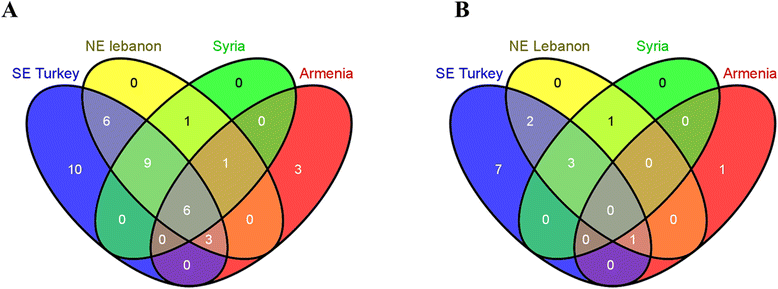Composition, variation, expression and evolution of low-molecular-weight glutenin subunit genes in Triticum urartu
- PMID: 25849991
- PMCID: PMC4364320
- DOI: 10.1186/s12870-014-0322-3
Composition, variation, expression and evolution of low-molecular-weight glutenin subunit genes in Triticum urartu
Abstract
Background: Wheat (AABBDD, 2n = 6x = 42) is a major dietary component for many populations across the world. Bread-making quality of wheat is mainly determined by glutenin subunits, but it remains challenging to elucidate the composition and variation of low-molecular-weight glutenin subunits (LMW-GS) genes, the major components for glutenin subunits in hexaploid wheat. This problem, however, can be greatly simplified by characterizing the LMW-GS genes in Triticum urartu, the A-genome donor of hexaploid wheat. In the present study, we exploited the high-throughput molecular marker system, gene cloning, proteomic methods and molecular evolutionary genetic analysis to reveal the composition, variation, expression and evolution of LMW-GS genes in a T. urartu population from the Fertile Crescent region.
Results: Eight LMW-GS genes, including four m-type, one s-type and three i-type, were characterized in the T. urartu population. Six or seven genes, the highest number at the Glu-A3 locus, were detected in each accession. Three i-type genes, each containing more than six allelic variants, were tightly linked because of their co-segregation in every accession. Only 2-3 allelic variants were detected for each m- and s-type gene. The m-type gene, TuA3-385, for which homologs were previously characterized only at Glu-D3 locus in common wheat and Aegilops tauschii, was detected at Glu-A3 locus in T. urartu. TuA3-460 was the first s-type gene identified at Glu-A3 locus. Proteomic analysis showed 1-4 genes, mainly i-type, expressed in individual accessions. About 62% accessions had three active i-type genes, rather than one or two in common wheat. Southeastern Turkey might be the center of origin and diversity for T. urartu due to its abundance of LMW-GS genes/genotypes. Phylogenetic reconstruction demonstrated that the characterized T. urartu might be the direct donor of the Glu-A3 locus in common wheat varieties.
Conclusions: Compared with the Glu-A3 locus in common wheat, a large number of highly diverse LMW-GS genes and active genes were characterized in T. urartu, demonstrating that this progenitor might provide valuable genetic resources for LMW-GS genes to improve the quality of common wheat. The phylogenetic analysis provided molecular evidence and confirmed that T. urartu was the A-genome donor of hexaploid wheat.
Figures





References
-
- D’Ovidio R, Masci S. The low-molecular-weight glutenin subunits of wheat gluten. J Cereal Sci. 2004;39(3):321–39. doi: 10.1016/j.jcs.2003.12.002. - DOI
-
- Juhász A, Gianibelli M. Low-molecular-weight glutenin subunits: insight into this abundant subunit group present in glutenin polymers. St Paul: AACC International Press; 2006. pp. 171–212.
-
- Ciaffi M, Tozzi L, Borghi B, Corbellini M, Lafiandra D. Effect of heat shock during grain filling on the gluten protein composition of bread wheat. J Cereal Sci. 1996;24(2):91–100. doi: 10.1006/jcrs.1996.0042. - DOI
Publication types
MeSH terms
Substances
LinkOut - more resources
Full Text Sources
Other Literature Sources

